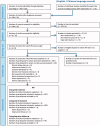Acupuncture treatments for infantile colic: a systematic review and individual patient data meta-analysis of blinding test validated randomised controlled trials
- PMID: 29338487
- PMCID: PMC5901442
- DOI: 10.1080/02813432.2018.1426146
Acupuncture treatments for infantile colic: a systematic review and individual patient data meta-analysis of blinding test validated randomised controlled trials
Abstract
Objective: Needle acupuncture in small children has gained some acceptance in Western medicine. It is controversial, as infants and toddlers are unable to consent to treatment. We aimed to assess its efficacy for treating infantile colic.
Design: A systematic review and a blinding-test validation based on individual patient data from randomised controlled trials. Primary end-points were crying time at mid-treatment, at the end of treatment and at a 1-month follow-up. A 30-min mean difference (MD) in crying time between acupuncture and control was predefined as a clinically important difference. Pearson's chi-squared test and the James and Bang indices were used to test the success of blinding of the outcome assessors [parents]. Eligibility criteria and data sources: We included randomised controlled trials of acupuncture treatments of infantile colic. Systematic searches were conducted in Cochrane CENTRAL, MEDLINE, EMBASE, CINAHL and AMED, and in the Chinese language databases CNKI, VIP, Wang fang, SinoMed and Chinese Clinical Trial Registry.
Results: We included three randomised controlled trials with data from 307 participants. Only one of the included trials obtained a successful blinding of the outcome assessors in both the acupuncture and control groups. The MD in crying time between acupuncture intervention and no acupuncture control was -24.9 min [95% confidence interval, CI -46.2 to -3.6; three trials] at mid-treatment, -11.4 min [95% CI -31.8 to 9.0; three trials] at the end of treatment and -11.8 min [95% CI -62.9 to 39.2; one trial] at the 4-week follow-up. The corresponding standardised mean differences [SMDs] were -0.23 [95% CI -0.42 to -0.06], -0.10 [95% CI -0.29 to 0.08] and -0.09 [95% CI -0.48 to 0.30]. The heterogeneity was negligible in all analyses. The statistically significant result at mid-treatment was lost when excluding the apparently unblinded study in a sensitivity analysis: MD -13.8 min [95%CI -37.5 to 9.9] and SMD -0.13 [95%CI -0.35 to 0.09]. The registration of crying during treatment suggested more crying during acupuncture [odds ratio 7.7; 95% CI 2.7-20.6; one trial]. GRADE-Moderate quality evidence.
Conclusions: Percutaneous needle acupuncture treatments should not be recommended for infantile colic on a general basis. Systematic review registration: PROSPERO 2015:CRD42015023253 Key points The role of acupuncture in the treatment of infantile colic is controversial. Available trials are small and present conflicting results. There were no clinically important differences between infants receiving acupuncture and no acupuncture control in this IPD meta-analysis of randomised controlled trials. The data indicate that acupuncture induces some treatment pain in many of the children. The study results indicate that percutaneous needle acupuncture should not be recommended for treatment of infantile colic on a general basis.
Keywords: Acupuncture; colic; infant; meta-analysis; review.
Figures
Similar articles
-
Acupuncture for infantile colic: a blinding-validated, randomized controlled multicentre trial in general practice.Scand J Prim Health Care. 2013 Dec;31(4):190-6. doi: 10.3109/02813432.2013.862915. Epub 2013 Nov 15. Scand J Prim Health Care. 2013. PMID: 24228748 Free PMC article. Clinical Trial.
-
Acupuncture reduces crying in infants with infantile colic: a randomised, controlled, blind clinical study.Acupunct Med. 2010 Dec;28(4):174-9. doi: 10.1136/aim.2010.002394. Epub 2010 Oct 18. Acupunct Med. 2010. PMID: 20959312 Free PMC article. Clinical Trial.
-
A pilot study of ST36 acupuncture for infantile colic.Acupunct Med. 2011 Jun;29(2):103-7. doi: 10.1136/aim.2010.003590. Epub 2011 Mar 29. Acupunct Med. 2011. PMID: 21450707 Clinical Trial.
-
Parent training programmes for managing infantile colic.Cochrane Database Syst Rev. 2019 Dec 3;12(12):CD012459. doi: 10.1002/14651858.CD012459.pub2. Cochrane Database Syst Rev. 2019. PMID: 31794639 Free PMC article.
-
Dietary modifications for infantile colic.Cochrane Database Syst Rev. 2018 Oct 10;10(10):CD011029. doi: 10.1002/14651858.CD011029.pub2. Cochrane Database Syst Rev. 2018. PMID: 30306546 Free PMC article.
Cited by
-
The effect of two types of minimal acupuncture on stooling, sleeping and feeding in infants with colic: secondary analysis of a multicentre RCT in Sweden (ACU-COL).Acupunct Med. 2021 Apr;39(2):106-115. doi: 10.1177/0964528420920308. Epub 2020 May 6. Acupunct Med. 2021. PMID: 32375501 Free PMC article. Clinical Trial.
-
Osteopathic treatment of infants with infantile colic/excessive crying: a prospective, multicentric, randomized controlled trial and nested observational trial.BMC Pediatr. 2025 Jan 30;25(1):77. doi: 10.1186/s12887-025-05413-1. BMC Pediatr. 2025. PMID: 39885436 Free PMC article. Clinical Trial.
-
An overview of systematic reviews of complementary and alternative therapies for infantile colic.Syst Rev. 2019 Nov 11;8(1):271. doi: 10.1186/s13643-019-1191-5. Syst Rev. 2019. PMID: 31711532 Free PMC article. Review.
-
A comparison of two assessment tools used in overviews of systematic reviews: ROBIS versus AMSTAR-2.Syst Rev. 2021 Oct 25;10(1):273. doi: 10.1186/s13643-021-01819-x. Syst Rev. 2021. PMID: 34696810 Free PMC article. Review.
-
A pilot study of parents' experiences of reflexology treatment for infants with colic in Finland.Scand J Caring Sci. 2020 Dec;34(4):861-870. doi: 10.1111/scs.12790. Epub 2019 Nov 20. Scand J Caring Sci. 2020. PMID: 31747081 Free PMC article.
References
-
- Wessel MA, Cobb JC, Jackson EB, et al. . Paroxysmal fussing in infancy, sometimes called colic. Pediatrics. 1954;14:421–435. - PubMed
-
- The Rome Foundation. 2016. Available from: http://theromefoundation.org/and http://www.webcitation.org/6mG5pslnl.
-
- Hyman PE, Milla PJ, Benninga MA, et al. . Childhood functional gastrointestinal disorders: neonate/toddler. Gastroenterology. 2006;130:1519–1526. - PubMed
-
- Benninga MA, Faure C, Hyman PE, et al. . Childhood functional gastrointestinal disorders: neonate/toddler. Gastroenterology. 2016;150:1443–1455.e2. - PubMed
-
- Drug and Therapeutics Bulletin Management of infantile colic. BMJ. 2013;347:f4102. - PubMed
Publication types
MeSH terms
LinkOut - more resources
Full Text Sources
Other Literature Sources
Medical





